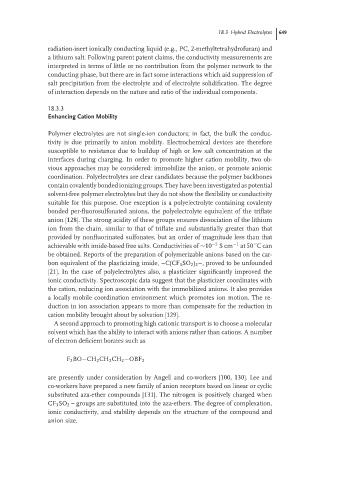Page 675 - Handbook of Battery Materials
P. 675
18.3 Hybrid Electrolytes 649
radiation-inert ionically conducting liquid (e.g., PC, 2-methyltetrahydrofuran) and
a lithium salt. Following parent patent claims, the conductivity measurements are
interpreted in terms of little or no contribution from the polymer network to the
conducting phase, but there are in fact some interactions which aid suppression of
salt precipitation from the electrolyte and of electrolyte solidification. The degree
of interaction depends on the nature and ratio of the individual components.
18.3.3
Enhancing Cation Mobility
Polymer electrolytes are not single-ion conductors; in fact, the bulk the conduc-
tivity is due primarily to anion mobility. Electrochemical devices are therefore
susceptible to resistance due to buildup of high or low salt concentration at the
interfaces during charging. In order to promote higher cation mobility, two ob-
vious approaches may be considered: immobilize the anion, or promote anionic
coordination. Polyelectrolytes are clear candidates because the polymer backbones
contain covalently bonded ionizing groups. They have been investigated as potential
solvent-free polymer electrolytes but they do not show the flexibility or conductivity
suitable for this purpose. One exception is a polyelectrolyte containing covalenty
bonded per-fluorosulfonated anions, the polyelectrolyte equivalent of the triflate
anion [128]. The strong acidity of these groups ensures dissociation of the lithium
ion from the chain, similar to that of triflate and substantially greater than that
provided by nonfluorinated sulfonates, but an order of magnitude less than that
◦
achievable with imide-based free salts. Conductivities of ∼10 −5 Scm −1 at 50 Ccan
be obtained. Reports of the preparation of polymerizable anions based on the car-
bon equivalent of the plasticizing imide, –C(CF 3 SO 2 ) 2 –, proved to be unfounded
[21]. In the case of polyelectrolytes also, a plasticizer significantly improved the
ionic conductivity. Spectroscopic data suggest that the plasticizer coordinates with
the cation, reducing ion association with the immobilized anions. It also provides
a locally mobile coordination environment which promotes ion motion. The re-
duction in ion association appears to more than compensate for the reduction in
cation mobility brought about by solvation [129].
A second approach to promoting high cationic transport is to choose a molecular
solvent which has the ability to interact with anions rather than cations. A number
of electron deficient borates such as
F 2 BO−CH 2 CH 2 CH 2 −OBF 2
are presently under consideration by Angell and co-workers [100, 130]. Lee and
co-workers have prepared a new family of anion receptors based on linear or cyclic
substituted aza-ether compounds [131]. The nitrogen is positively charged when
CF 3 SO 2 – groups are substituted into the aza-ethers. The degree of complexation,
ionic conductivity, and stability depends on the structure of the compound and
anion size.

